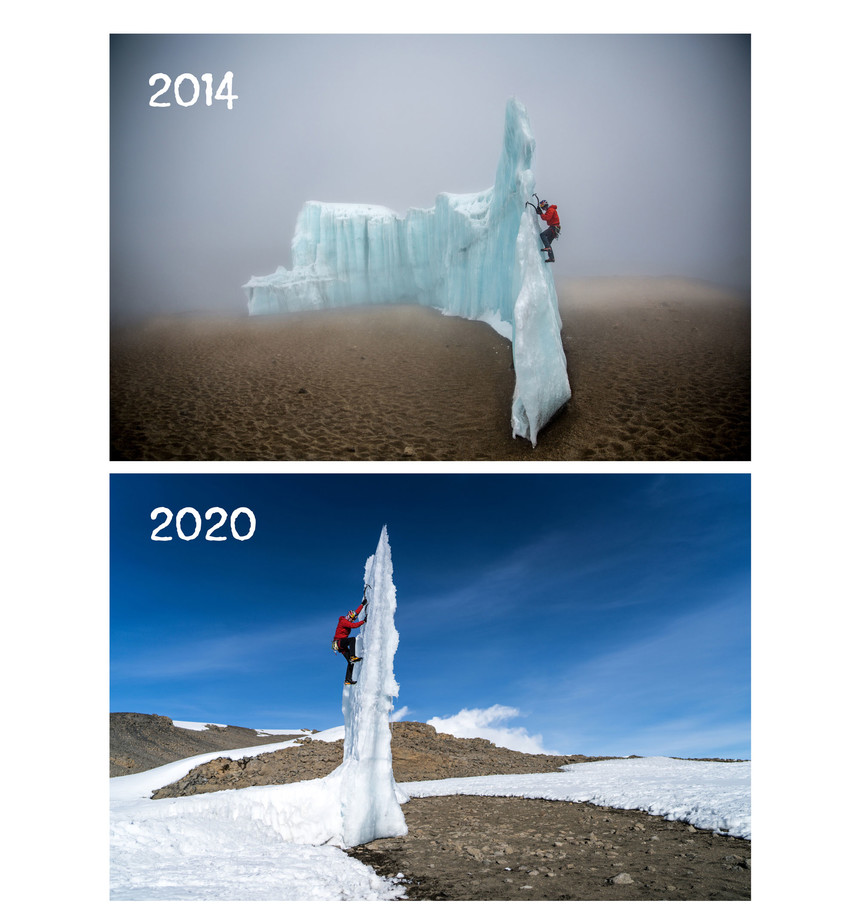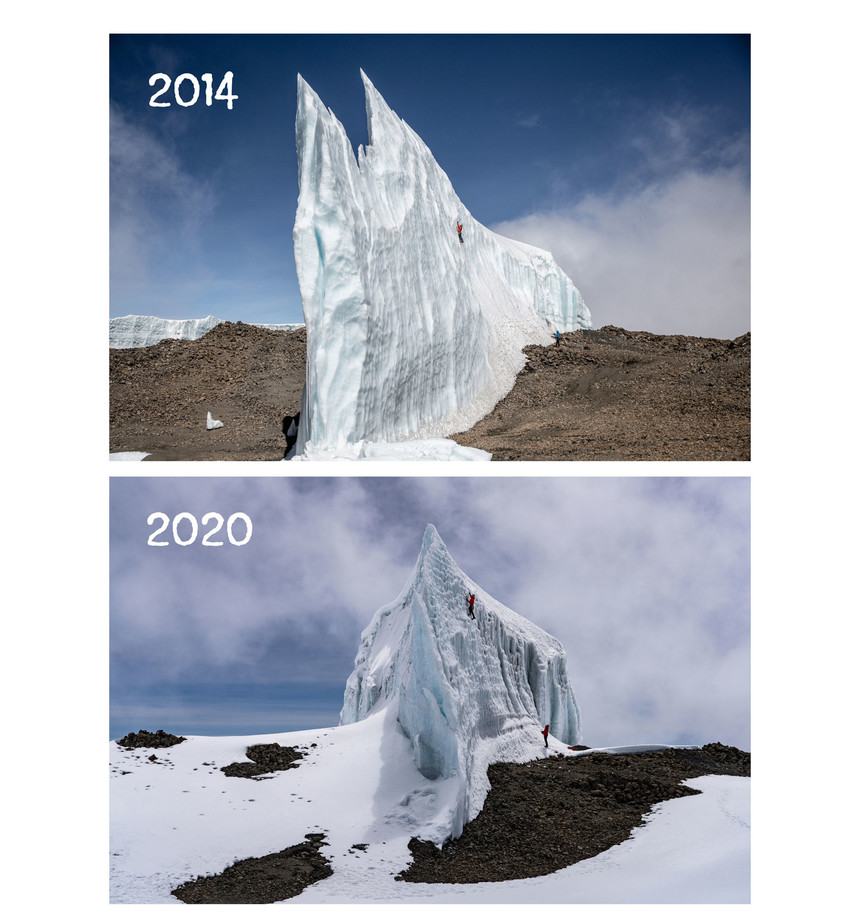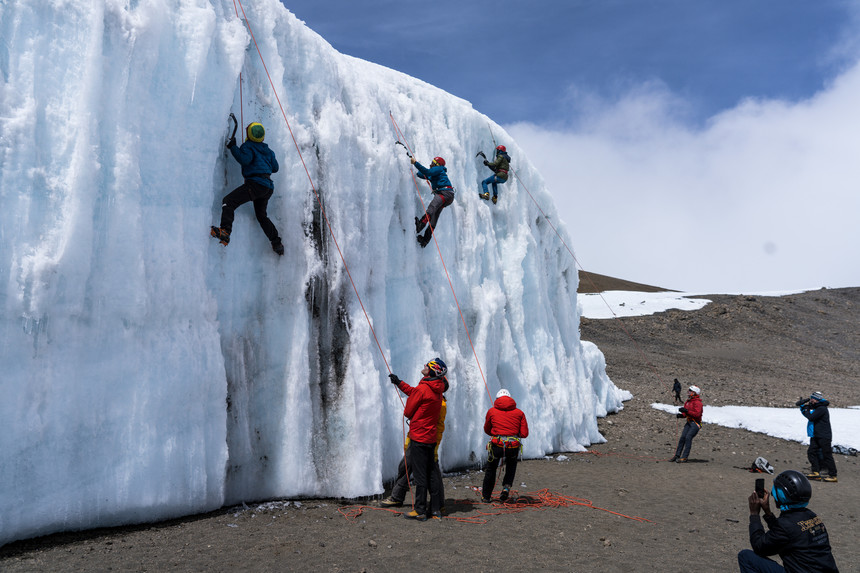
How Kilimanjaro’s Dwindling Glaciers are Warning Sign for the Rest of Us
The Reality of Last Ascents
Story by Katie LozancichMany athletes are watching the landscapes they love to recreate in change before their eyes due to climate change-- particularly in winter sports. For ice climber Will Gadd, this meant watching glaciers he's climbed in the past melt before his eyes on an expedition to Africa. There's always been a huge focus on first ascents in climbing, but how about last ones?
First ascents have always been a laurel sought after by bright-eyed adventurers and explorers alike. The act is synonymous with glory. On top of the notoriety and praise, being the first often means you get to join the ranks of the Tenzing Norgays and Edmund Hillarys by having your name cemented in the route’s history. But as our planet adapts to a rapidly changing climate, so do our mountains. Many adventurers are finding that instead of claiming to be the first up a route, they’re now the last. Iconic climbing routes all over the world are changing before our eyes. Factors like dangerous rockfall due to permafrost melting, narrower weather windows, and rapidly receding glaciers are making some famous routes increasingly difficult, or even impossible.
Glaciers in particular are feeling the effects of climate change the most and no corner of the globe seems to be safe. For example, in the Himalayas, the rate of melting has doubled since 2000, and researchers fear that most central and eastern Himalayan glaciers will be gone by 2035. Here in the United States it’s a similar story. The glaciers that famously give Montana’s Glacier National Park its name are expected to be gone by 2050.
For ice climbers like Will Gadd, it’s a wake up call. Ice climbing has brought him all over the globe, and he’s seeing dramatic changes firsthand. These days, when he plans an expedition, Gadd is grappling with the reality that the objective might look different, or might not even be there at all. Recently, he dealt with this dilemma on his second expedition to climb Kilimanjaro’s glaciers. He first visited Africa’s roof in 2014, finding hauntingly beautiful ice towers shaped like shark fins and serrated mountain ridges. The landscape mesmerized him, and he went on to make several first ascents on the structures. Given that Kilimanjaro’s glaciers have diminished by 90 percent since 1912, Gadd knew that these glaciers were headed for extinction. He expected to see some change when he returned six years later to climb the famous Messner route, but nothing would prepare him for what he found.

The famous shark fin that Gadd climbed back in 2014 barely exists anymore. Christian Pondella photo.
The top of Kilmanjaro looked like a completely different landscape. Changes in the atmosphere’s humidity ravaged this fragile ecosystem so aggressively that some glaciers had shrunk by 70 percent in that six-year time frame alone. The beautiful shark fins he once climbed were now mere ice cubes, and some ceased to exist at all. The Messner route, famously climbed by Reinhold Messner back in 1978, was too dangerous to even attempt due to thin coverage and looming rockfall dangers. Gadd thought he’d maybe be the last person to ever climb it, but now wonders if that window has closed completely. Gadd documented his 2020 expedition in a powerful short film called The Last Ascent. It’s an emotional piece that follows him and his team as they take in the changing landscape firsthand. We sat down with Gadd to hear a little more about the project, and how the experience has pushed him to live a more sustainable climate-friendly lifestyle.
What originally led you to ice climb on Kilimanjaro?
Will Gadd: I just wanted to climb ice in Africa! How unlikely is that? I just thought it would be a cool thing to do. That’s how most of my adventures come about, you know, I think of some wild idea and try to make it happen.
Were you also worried that you were running out of time as well?
WG: Yeah, I saw how the glaciers in my local mountains were retreating quickly, so I figured the ice on Kilimanjaro wasn’t going to last a long time. If I wanted to climb ice in Africa I need to get on it and make it happen. I just had no idea how quickly it would change.

What is so unique about climbing out there?
WG: I mean you’re ice-climbing in Africa—so that’s amazing just by itself. Also, the people are incredible. They’ve been guiding on that mountain for a long time, and they have such a vast understanding of the mountain. This didn’t make the film, but we took the whole guiding team ice climbing, and they were so psyched. I’m glad they got to experience the mountain in a new way.
Did you go into this project knowing that the narrative would be focused on climate change?
WG: I was worried about the situation, and wanted to get to the Messner route before it was gone. I genuinely thought it would be there. To show up on Kilimanjaro, and see that the ice I climbed in 2014 is half the size now or gone—it was a shock. I didn’t think the project would be focused on climate change, and I didn’t want it to be political. But this documentary was meant to show you what was happening, and I hope people see the changes and understand that it is real.
This film explores the idea of last ascents, which is, unfortunately, becoming a harsh byproduct of climate change. How do you sit with this idea as a professional athlete?
WG: I think it’s already had an impact on me. Before the film, I was starting to look and think about how I can understand this situation better. I did a film in the fall of 2019 that was helping some researchers study ice melt in Greenland. I kept hearing that “Greenland is melting” but I wanted to know what that looked like. That film was trying to answer that question.
As an athlete, it’s distributing. As an ice climber, I’m starting to feel like an old fashioned canary in the coal mine. I’m seeing the effects of climate change first because it’s affecting my sport dramatically. I’m lucky to live in one of the few places that still has really reliable ice climbing for five-six months of the year, but it’s not like that in other places. It makes me sad, and seeing the changes in the mountains feels so unprecedented. I guess as an athlete I want to use my knowledge to show what’s happening.

Detail of a side-by-side comparison of the glacial recession on Kilimanjaro. Christian Pondella photo.
Going into this film I knew it was going to be hard to see the changes in the glaciers. How was it for you to see this landscape change firsthand?
WG: It was a lot to take in—especially being there as well. I hope people watch the film and see the differences, and not just think “Oh, Climate change is just a temperature difference on a graph.” This film was meant to show you what it actually looks like.
Over the last few decades, adventure athletes like yourself have been sounding the alarm regarding climate change. What have you noticed over your career that’s caused you to speak up about it?
WG: I travel to mountain ranges all over the world and have for a long time, so I have a record of these places in my head. Everywhere I go the glaciers are a lot smaller. Consistently I’m seeing a shorter ski and ice climbing season. In France, for example, you get off the cable car to go to the Mer de Glace and it used to be right there. Now you go down an endless set of ladders to get to the glacier. A lot of the little ski areas in the Alps can’t even make a go of it anymore because it’s too warm.
As a guide here in Canada, some peaks where I’ve always guided aren't possible anymore because the glacier access is changing. It’s no longer safe. The permafrost is melting out, resulting in a lot more rockfall, creating more climbing hazards. When I was a kid my local glacier, the Athabasca Glacier, used to be right there from the parking lot. You can barely see the thing now from the parking lot. You literally have to go a mile over bedrock to get to it. Glaciers do come and go, but I think what people aren’t realizing is that the rate glaciers are disappearing is alarming. That’s not normal, and it doesn’t make any sense without human intervention.
To put it in my perspective as a guide—imagine if you showed up to work and your office was gone? That’s how I feel seeing these glaciers disappear.

Will Gadd teaches his porters and guide to ice climb on Kilimanjaro's glaciers. Christian Pondella photo.
It shows how losing these places has such a dramatic ripple effect. There are communities all over the world whose economies depend on snow, ice, and outdoor tourism.
WG: There’s a much bigger picture here. It’s the people who live in these environments that unfortunately pay the biggest price. For the Massai people in Tanzania, if you don’t get reliable wet seasons, this problem quickly becomes more than just about sports but about a way of life.
Back home in Canada, a lot of the rivers here are dependent on glacial water and a lot of the water supply for Western Canada comes from these rivers. As those rivers decrease in volume, you end up with less water. I think all of us will start feeling these changes.
In the film, you admitted that this trip was a turning point for making changes in your day to day life.
WG: Yeah it’s been this kind of awakening, and I’ve done three science-based explorations now. I think my big awakening from these trips is we can’t keep on the path that we’re going—but I don’t have the answers on how to fix that. I have to wrestle with as best that I can and come up with solutions for myself, my family, and my community. The Kilimanjaro trip really shook me up.
Can you share some ways you’re trying to be more sustainable?
WG: I started small. I decided to reduce my meat consumption by 20%, and then I eventually became a weekday vegetarian. So my family eats plant-based from Monday through Friday which has drastically reduced our meat consumption. And honestly, it hasn’t been that hard and we feel great. One decision we also made was to make one of our vehicles a fuel-efficient vehicle. There are also little things you can do, for example, when my chainsaw died I replaced it with an electric chainsaw.
But the biggest thing I’m trying to grapple with is the flying. I’m a professional athlete so in a normal year I fly over 100,000 miles—and that’s not sustainable. COVID has obviously helped with that, but before Kilimanjaro, I was able to bring that down by 20%. Carbon offsets help, but it’s not a long-term solution. The goal is always to reduce the amount of flying I'm doing, so as a result I’m trying to be more careful with the projects that I accept. If I’m going to fly to Europe then I want to spend a month there and do five things while I’m there—rather than make three trips there in a year.
Lastly, I can vote for clean energy in the grid. If you believe in sustainability and fighting against climate change, then you need to make your voice heard. The targets we’re trying to reach are not impossible.

Will Gadd takes the scenic route down from the summit of Mt Kilimanjaro. Christian Pondella photo.
Has this emphasis on sustainability pushed you to look at your backyard more for adventures, rather than travel somewhere for an adventure?
WG: There’s a tremendous amount of rock climbing and ice climbing right from my house, which is why I live here. I haven’t been on a jet in six months, which is pretty rare and honestly, I like it. I think traveling is great and you can learn a lot from the experiences but there’s something to be said about staying local and loving the place you call home.
